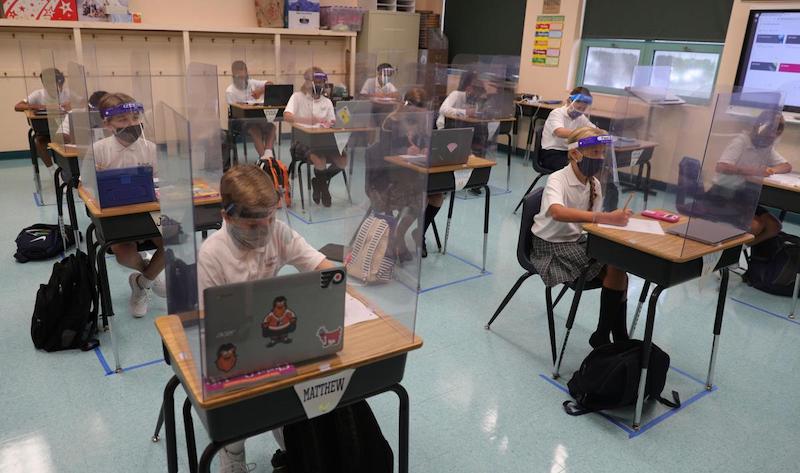posted: October 23, 2021
tl;dr: Kids have suffered greatly and needlessly during COVID-19 because of the paranoia of adults...
It didn’t receive much press, but this week the American Academy of Pediatrics (AAP) declared a “National Health Emergency in Children’s Mental Health”, stating that “the COVID-19 pandemic has taken a serious toll on children's mental health as young people continue to face physical isolation, ongoing uncertainty, fear and grief.” Among the grim statistics cited: “a more than 50 percent increase in suspected suicide attempt emergency department visits among girls ages 12-17 in early 2021 as compared to the same period in 2019.” Unfortunately, it didn’t surprise me one bit.
As a country we’ve made many mistakes in responding to the COVID-19 pandemic. Here’s my partial list:
Aside from that last item, the biggest mistake we’ve made, and continue to make, is how we’ve managed the virus with respect to younger Americans.

Kids in cages, at St. Joseph Regional School in Somers Point, New Jersey, Fall 2020 (from The Press of Atlantic City)
It was clear from the very early stages of the pandemic that adverse outcomes from exposure to the SARS‑CoV‑2 virus skewed heavily towards the elderly, especially those with comorbidities. For kids, the SARS‑CoV‑2 virus is no worse than a typical flu virus. The Oxford Center for Evidence-Based Medicine (CEBM) compiled and published some of the best early population studies of the impact of COVID-19. In April and May of 2020 it was clear to me and anyone else reading that data, rather than listening to our politicians, that the pandemic was going to be nowhere near as bad (especially for kids) as many were fearing when Italy was posting a 6% Case Fatality Rate. By focusing on studies of small populations where everyone had been exposed to the SARS‑CoV‑2 virus, the Oxford CEBM was able to accurately predict the long-term population fatality rate, at between 0.2% and 0.4%.
Many parents, however, are incredibly paranoid about and protective of their kids. I understand this fear, but it can lead to bad outcomes when kids are denied access to the joys of life. My wife and I have always been much more willing than other parents to let our kids “free range”. Yes, there’s a small risk that, when you let your fourth grader walk to school without adult supervision, they could be snatched by a kidnapper and end up on the back of a milk carton. Or a junior-high kid taking the train into the “big city” to visit a museum could be shot at by street criminals. But those risks, like the risk of a child dying from COVID-19, are very small.
Parents will often say “I just want my children to be happy”. If that statement is to be true, then parents need to give their children some freedom, to both have fun and to potentially make mistakes. There is always a small chance that something could go terribly wrong, but that’s a fact of life. It’s a tragedy when a child dies before his or her parents, but that outcome used to be fairly common in centuries past and somehow people and society survived. It’s one reason for parents to consider having more than one child.
When I see a masked, plexi-glassed, socially distanced classroom, I feel incredibly sad for the kids. The phrase “kids in cages” leaps immediately to mind, although it’s been used in other contexts. These “cages” are not about the kids at all: they are all about the teachers, politicians, and the paranoid parents. The kids are being denied a normal childhood by the adults in charge, and they are suffering tremendously because of it.
Kids not in cages, at Camp Randall at the University of Wisconsin, Madison, Fall 2021
Even when I was a student in the 1970s and 1980s, I felt that public school was too regimented and too jail-like. It’s only gotten more so over the decades leading up to COVID-19, where it has now gone into overdrive. I was so happy when I went to Cornell after public high school because the university treated us like adults. They didn’t take attendance; the professors didn’t care if you showed up to lectures or not; the administration didn’t tell you when to eat, sleep, exercise, or socialize. All that mattered, for your grades, was how well you performed on tests, papers, and assignments. I knew a few very bright fellow students who never went to class, yet got excellent grades. They did whatever worked for them to learn the material, and no one cared. They were given freedom.
In 2020 Cornell handled COVID-19 better than many universities, by allowing students to return to campus while still taking most of their classes over video. Alas, in 2021 Cornell is still placing some restrictions on student life, even though the vaccination rate is close to 100%. Reluctantly, I have to classify them as mildly COVID-paranoid. Meanwhile there have been scenes like this video from a sold-out University of Wisconsin football game, with 80,000 fans celebrating together. It is by far the most joyful video I have seen of life in the United States in the year 2021.
Let’s stop damaging, and in some cases destroying, the lives of our children because of a virus that directly causes a negative outcome only in rare cases. Let them go about their business normally. Let them have some fun.
Related post: Living with the virus
Related post: A pandemic of risk aversion
Related post: The failures of the elites: COVID-19 kids policies